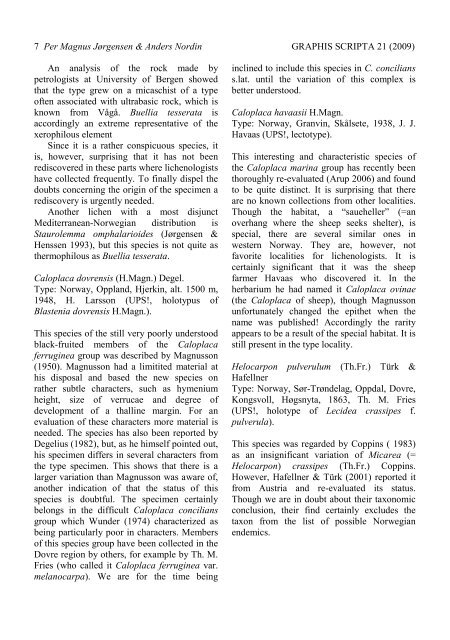(2009): Lichens in Scandinavia known mainly from Norwegian type ...
(2009): Lichens in Scandinavia known mainly from Norwegian type ...
(2009): Lichens in Scandinavia known mainly from Norwegian type ...
Create successful ePaper yourself
Turn your PDF publications into a flip-book with our unique Google optimized e-Paper software.
7 Per Magnus Jørgensen & Anders Nord<strong>in</strong> GRAPHIS SCRIPTA 21 (<strong>2009</strong>)<br />
An analysis of the rock made by<br />
petrologists at University of Bergen showed<br />
that the <strong>type</strong> grew on a micaschist of a <strong>type</strong><br />
often associated with ultrabasic rock, which is<br />
<strong>known</strong> <strong>from</strong> Vågå. Buellia tesserata is<br />
accord<strong>in</strong>gly an extreme representative of the<br />
xerophilous element<br />
S<strong>in</strong>ce it is a rather conspicuous species, it<br />
is, however, surpris<strong>in</strong>g that it has not been<br />
rediscovered <strong>in</strong> these parts where lichenologists<br />
have collected frequently. To f<strong>in</strong>ally dispel the<br />
doubts concern<strong>in</strong>g the orig<strong>in</strong> of the specimen a<br />
rediscovery is urgently needed.<br />
Another lichen with a most disjunct<br />
Mediterranean-<strong>Norwegian</strong> distribution is<br />
Staurolemma omphalarioides (Jørgensen &<br />
Henssen 1993), but this species is not quite as<br />
thermophilous as Buellia tesserata.<br />
Caloplaca dovrensis (H.Magn.) Degel.<br />
Type: Norway, Oppland, Hjerk<strong>in</strong>, alt. 1500 m,<br />
1948, H. Larsson (UPS!, holotypus of<br />
Blastenia dovrensis H.Magn.).<br />
This species of the still very poorly understood<br />
black-fruited members of the Caloplaca<br />
ferrug<strong>in</strong>ea group was described by Magnusson<br />
(1950). Magnusson had a limitited material at<br />
his disposal and based the new species on<br />
rather subtle characters, such as hymenium<br />
height, size of verrucae and degree of<br />
development of a thall<strong>in</strong>e marg<strong>in</strong>. For an<br />
evaluation of these characters more material is<br />
needed. The species has also been reported by<br />
Degelius (1982), but, as he himself po<strong>in</strong>ted out,<br />
his specimen differs <strong>in</strong> several characters <strong>from</strong><br />
the <strong>type</strong> specimen. This shows that there is a<br />
larger variation than Magnusson was aware of,<br />
another <strong>in</strong>dication of that the status of this<br />
species is doubtful. The specimen certa<strong>in</strong>ly<br />
belongs <strong>in</strong> the difficult Caloplaca concilians<br />
group which Wunder (1974) characterized as<br />
be<strong>in</strong>g particularly poor <strong>in</strong> characters. Members<br />
of this species group have been collected <strong>in</strong> the<br />
Dovre region by others, for example by Th. M.<br />
Fries (who called it Caloplaca ferrug<strong>in</strong>ea var.<br />
melanocarpa). We are for the time be<strong>in</strong>g<br />
<strong>in</strong>cl<strong>in</strong>ed to <strong>in</strong>clude this species <strong>in</strong> C. concilians<br />
s.lat. until the variation of this complex is<br />
better understood.<br />
Caloplaca havaasii H.Magn.<br />
Type: Norway, Granv<strong>in</strong>, Skålsete, 1938, J. J.<br />
Havaas (UPS!, lecto<strong>type</strong>).<br />
This <strong>in</strong>terest<strong>in</strong>g and characteristic species of<br />
the Caloplaca mar<strong>in</strong>a group has recently been<br />
thoroughly re-evaluated (Arup 2006) and found<br />
to be quite dist<strong>in</strong>ct. It is surpris<strong>in</strong>g that there<br />
are no <strong>known</strong> collections <strong>from</strong> other localities.<br />
Though the habitat, a “saueheller” (=an<br />
overhang where the sheep seeks shelter), is<br />
special, there are several similar ones <strong>in</strong><br />
western Norway. They are, however, not<br />
favorite localities for lichenologists. It is<br />
certa<strong>in</strong>ly significant that it was the sheep<br />
farmer Havaas who discovered it. In the<br />
herbarium he had named it Caloplaca ov<strong>in</strong>ae<br />
(the Caloplaca of sheep), though Magnusson<br />
unfortunately changed the epithet when the<br />
name was published! Accord<strong>in</strong>gly the rarity<br />
appears to be a result of the special habitat. It is<br />
still present <strong>in</strong> the <strong>type</strong> locality.<br />
Helocarpon pulverulum (Th.Fr.) Türk &<br />
Hafellner<br />
Type: Norway, Sør-Trøndelag, Oppdal, Dovre,<br />
Kongsvoll, Høgsnyta, 1863, Th. M. Fries<br />
(UPS!, holo<strong>type</strong> of Lecidea crassipes f.<br />
pulverula).<br />
This species was regarded by Copp<strong>in</strong>s ( 1983)<br />
as an <strong>in</strong>significant variation of Micarea (=<br />
Helocarpon) crassipes (Th.Fr.) Copp<strong>in</strong>s.<br />
However, Hafellner & Türk (2001) reported it<br />
<strong>from</strong> Austria and re-evaluated its status.<br />
Though we are <strong>in</strong> doubt about their taxonomic<br />
conclusion, their f<strong>in</strong>d certa<strong>in</strong>ly excludes the<br />
taxon <strong>from</strong> the list of possible <strong>Norwegian</strong><br />
endemics.

















